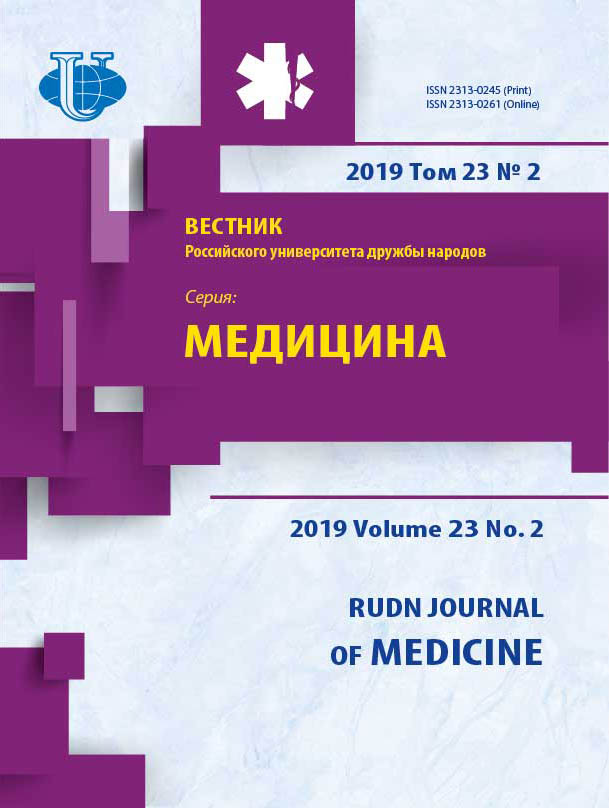FEATURES OF MANAGING PATIENTS AFTER THE FEMOROPOPLITEAL BYPASS
- Authors: Kasianov B.V.1
-
Affiliations:
- Orel State University
- Issue: Vol 23, No 2 (2019)
- Pages: 168-173
- Section: SURGERY
- URL: https://journals.rudn.ru/medicine/article/view/21356
- DOI: https://doi.org/10.22363/2313-0245-2019-23-2-168-173
Cite item
Full Text
Abstract
The approach to managing patients after femoropopliteal bypass surgery among vascular surgeons, even of one country, is sometimes not the same. The main difficulty is the problem of the late postoperative period patency of femoropopliteal bypasses (FPB). Aim. Analysis of the risk factors for occlusion of the FPB and the effects of postoperative diagnostic ultrasound on the primary, primary-assisted patency and secondary patency of such bypasses. Materials and methods. The Pubmed database was analyzed and the studies were selected from 2007 till 2017. The effect of preoperative risk factors on the FPB’s primary patency was evaluated in patients of the department of vascular surgery at the Orel regional hospital in comparison with the of foreign researchers’ data. The second stage was the evaluation of the effect of ultrasound diagnostic on the primary, primary-assisted and secondary patency of such bypasses. Results. The greatest impact on the primary patency of FPB was exerted by the presence of CLI, arterial hypertension and the male gender, and a slightly fewer by smoking and angina pectoris (χ2 cf. = -0.983-0.985*). The effect of diabetes was 2 times weaker (χ2 = -0.547*). Ultrasound control, in turn, had the greatest impact on the frequency of primary-assisted patency compared with the group without ultrasound control (81.3% vs. 76.1%). The frequencies of primary patency (67.4% vs. 64.9%) and secondary patency (83.2% vs. 82.8%) turned out to be almost comparable between the two groups of patients. Conclusions. Thus, the male sex, arterial hypertension and CLI are the most significant pre-operative risk factors affecting the primary patency of FPB. Regular diagnostic ultrasound in the postoperative period, especially in the period of 4-6 weeks, 3 months, 6 months and 1 year, allows to improve long-term results of such bypasses’ patency.
About the authors
B. V. Kasianov
Orel State University
Author for correspondence.
Email: borys.kasianov@gmail.com
Orel, Russian Federation
References
- Miroljubov B.M., Kamaltdinov R.R. Sravnitel'nye rezul'taty bedrenno-podkolennogo i gluboko bedrenno-podkolennogo shuntirovanija. International Research Journal. С. 67. doi: 0.18454/IRJ.2016.44.126.
- Gavrilenko A.V., Skrylev S.I. Otdalennye rezul'taty bedrenno-podkolennyh autovenoznyh shuntirovanij reversirovannoj venoj i po metodike «in situ». Angiologija i sosudistaja hirurgija. 2007; 13(3):120-124.
- Oresanya L. et al. Factors associated with primary vein graft occlusion in a multicenter trial with mandated ultrasound surveillance. Journal of vascular surgery. 2014;59(4):996-1002. doi: 10.1016/j.jvs.2013.10.096.
- Aluhanjan O.A. i dr. Otdalennye rezul'taty rekonstruktivnyh vmeshatel'stv na bedrenno-podkolenno-bercovom arterial'nom segmente pri razlichnoj emkosti distal'nogo rusla. Kubanskij nauchnyj medicinskij vestnik. 2015; 6:155. https://doi.org/10.25207/1608-6228-2015-6-9-12.
- Mofidi R. et al. Validation of a decision tree to streamline infrainguinal vein graft surveillance. Annals of vascular surgery. 2017;40:216-222. https://doi.org/10.1016/ j.avsg.2016.07.082.
- McBride O.M.B. et al. Development of a decision tree to streamline infrainguinal vein graft surveillance. Annals of vascular surgery. 2016;36:182-189. https://doi.org/ 10.1016/j.avsg.2016.02.031.
- Tinder C.N. et al. Efficacy of duplex ultrasound surveillance after infrainguinal vein bypass may be enhanced by identification of characteristics predictive of graft stenosis development. Journal of vascular surgery. 2008; 48:(3):613-618. https://doi.org/10.1016/j.jvs.2008.04.053.
- De Marino P.M. et al. Results of infrainguinal bypass in acute limb ischaemia. European Journal of Vascular and Endovascular Surgery. 2016;51(6):824-830. https://doi.org/10.1016/j.ejvs.2016.03.023.
- Reifsnyder T. et al. Contemporary outcomes for open infrainguinal bypass in the endovascular era. Annals of vascular surgery. 2016; 30: 52-58. https://doi.org/ 10.1016/j.avsg.2015.10.003.
- Mills Sr J.L. et al. The society for vascular surgery lower extremity threatened limb classification system: risk stratification based on wound, ischemia, and foot infection (WIfI). Journal of vascular surgery. 2014; 59(1):220-234. https://doi.org/10.1016/j.jvs.2014.11.045.
















